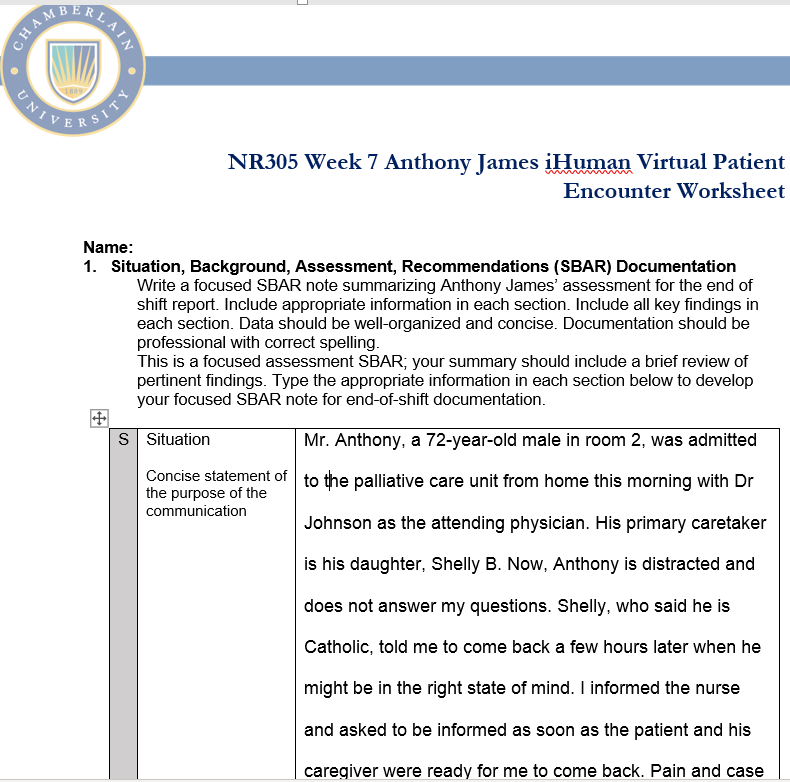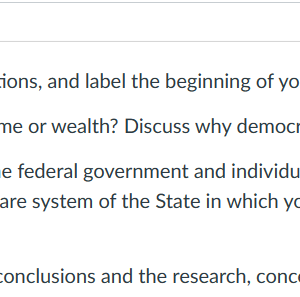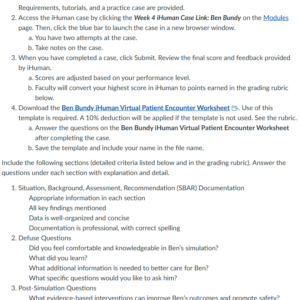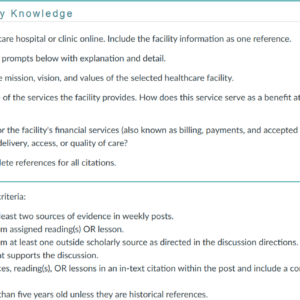CLASS:
NR305 – Health Assessment for the Practicing RN
Directions
- Review the iHuman Virtual Patient Encounter Orientation in Week 1 Modules if needed. Requirements, tutorials, and a practice case are provided.
- Access the iHuman case by clicking the Week 7 iHuman Case Link: Anthony James on the Modules page. Then, click the blue bar to launch the case in a new browser window.
- You have two attempts at the case.
- Take notes on the case.
- When you have completed a case, click Submit. Review the final score and feedback provided by iHuman.
- Scores are adjusted based on your performance level.
- Faculty will convert your highest score in iHuman to points earned in the grading rubric below.
- Download the Anthony James iHuman Virtual Patient Encounter WorksheetLinks to an external site.. Use of this template is required. A 10% deduction will be applied if the template is not used. See the rubric.
- Answer the questions on the Anthony James iHuman Virtual Patient Encounter Worksheet after completing the case.
- Save the template and include your name in the file name.
Include the following sections (detailed criteria listed below and in the grading rubric). Answer the questions under each section with explanation and detail.
- Situation, Background, Assessment, Recommendation (SBAR) Documentation
- Appropriate information in each section
- All key findings mentioned
- Data is well-organized and concise
- Documentation is professional, with correct spelling
- Defuse Questions
- Did you feel comfortable and knowledgeable in Anthony’s simulation?
- What did you learn?
- What additional information is needed to better care for Anthony?
- What specific questions would you like to ask his caregiver?
- Post-Simulation Questions
- Discuss the importance of balancing the psychological aspects of end-of-life care, such as pain management and symptom control, with the psychosocial and emotional needs of the client and family when developing and implementing a plan of care for clients at the end of their life.
- Discuss how you can ensure that established protocols, like pain management, are effectively tailored to each client’s unique needs and preferences to provide client-centered care.
- Provide the full APA reference for the scholarly source.
SOLUTION
| S | Situation
Concise statement of the purpose of the communication
|
The palliative care unit received Mr. Anthony as a 72-year-old male patient today in room 2 from home under the care of Dr. Johnson. His daughter, Shelly B., serves as his primary caregiver. Mr. Anthony demonstrates a state of distraction because he refuses to cooperate with my interview questions. The healthcare team member Shelly requested my return after several hours since he followed Catholic beliefs. I informed the nursing staff about the situation and requested notification only when the patient alongside his caregiver felt ready to meet with me. Received assessments from pain management, case management, and pastoral care departments will be relayed to the healthcare professional when patient pain becomes uncontrolled. |
…………………purchase at $10





Reviews
There are no reviews yet.